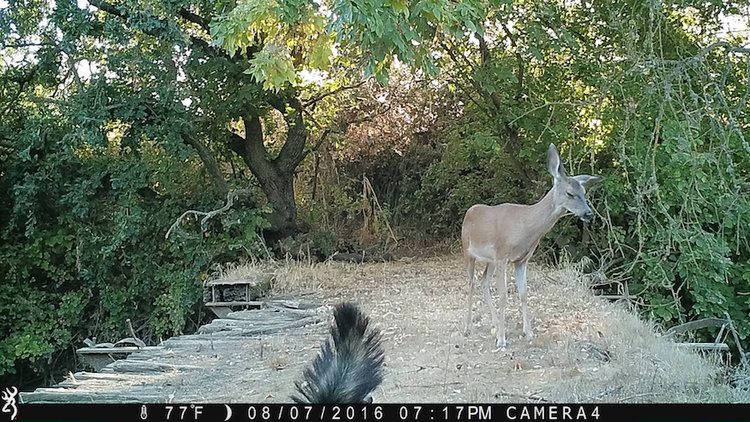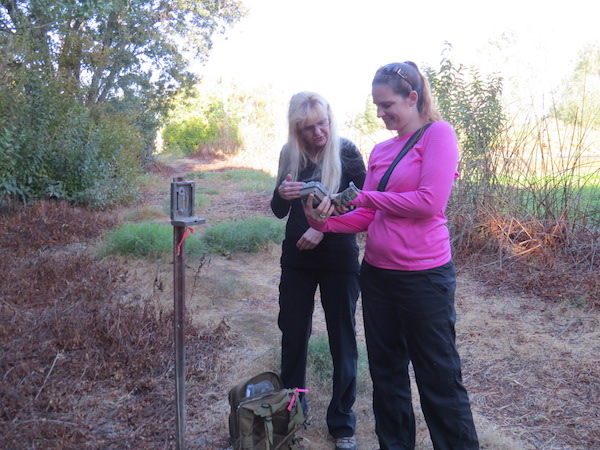Cosumnes River Preserve Mountain Lion Camera Trap Project
Begun March 2014 – Concluded March 2018
The Preserve’s mountain lion camera trap project was conducted over the course of four years. It began in 2014 when the Bureau of Land Management initiated the project in collaboration with the California Department of Fish and Wildlife. For the last three years, the study was carried forward by our all-volunteer crew of dedicated individuals with continued support and oversight from the Bureau of Land Management. As of March 2018, the project has concluded.
Four years of wildlife image data was collected, culminating in thousands of images of the Preserve’s wild residents, including: bobcats, coyotes, foxes, river otters, raccoons, skunks, opossums, beavers, deer, jack rabbits, cottontail rabbits, western gray squirrels, eastern fox squirrels, great horned owls, barn owls, raptors, bats, great egrets, snowy egrets, great blue herons, black phoebes, scrub jays, towhees and more. However, to date, we have been unable to provide a photographic image of a mountain lion on the Preserve even though there have been several reliable sightings since May 2017. It’s confirmed, though not officially, that lions reach the Preserve to explore the rich habitat and resources it offers.
We wish to thank the Bureau of Land Management and the Cosumnes River Preserve for their continued support and encouragement as our volunteer effort regularly monitored trail cameras in hopes of finding a mountain lion. And thank you to all the volunteers who tirelessly monitored the trail cameras, rain or shine, and went above and beyond many times to keep the cameras rolling and the data coming in.
The Goal
The goal of the project was to find and document a mountain lion on the Cosumnes River Preserve through images we captured on the trail cameras we deployed and monitored on known wildlife travel corridors such as roads, and pinch points, such as levees and water crossings. The next step would have been to track and trap the lion, collect DNA and fit the animal with a GPS tracking collar. This would have provided important data on the origins of the lion and his or her movement, behavior and prey use on the Preserve. The data collected would have helped inform us about populations and dispersal patterns of mountain lions in the Great Central Valley as they continue to attempt to disperse in search of new territory and mates.
There is no doubt that there are mountain lions who disperse along the Cosumnes River corridor and find themselves in the Central Valley near Wilton and Herald. What we don’t know and hoped to provide data for, was what they do and where they go when they’re here and whether mountain lions from the Coast Ranges are able to disperse across the Valley and interbreed with Sierra Nevada lions and vice versa. This would show that genetic diversity exists within the Central Valley populations and that lions are surviving and finding corridors to make it across the Valley.
Reliable visual sightings on the Preserve occur from time to time, indicating that some lions make it to the Lower Preserve.
The Hope
Just because we didn’t get a mountain lion on one of our cameras does not mean they aren’t out there padding around in remote areas of the Preserve, eating deer. We’ll never know if a mountain lion chanced to pass close to one of our cameras, just passing behind it or just out of range instead of in front of it.
We remain hopeful that one day new data will be collected, increasing our understanding of how mountain lions attempt to use the Central Valley and perhaps even contributing to the preservation of important wildlife travel corridors within the Valley and Bay Delta regions. This would go a long way towards conserving mountain lion populations that are currently struggling with many threats to their survival. Today, the main threats to mountain lions are human persecution and man made environmental impacts such as rodenticide use and habitat loss through human development, wildlife travel corridor destruction and climate change.
Mountain lions are native predators and we need them to maintain healthy ecosystems. And we need healthy ecosystems for our own survival.
Thank you for following our story. For the lions.
Some ‘Best of’ Camera Captures Taken Throughout The Study
The Critters – We got many wonderful images over the course of the project, some beautiful, some humorous and always giving us a glimpse into the incredible diversity of wildlife on the Preserve and animal movement and behavior there. Here are just a few.












The Crew – a truly dedicated bunch who were committed to finding a mountain lion on our cameras. We always learned a lot, laughed a lot and enjoyed the special privilege of being ‘behind the gates,’ able to observe firsthand the incredible beauty and importance of the Preserve’s vital protected habitats that are home to so many wild ones.



















![]()
